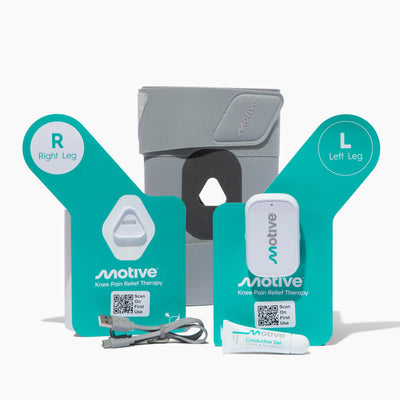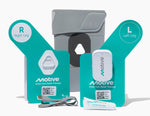
Knee pain is one of the most common problems observed in people of all ages. Nevertheless, it is more frequently observed in individuals over the age of 50 and stands as a prominent cause of disability within this demographic.
The factors that contribute to knee problems mainly include aging, a sedentary lifestyle, and rising body weight. Healthcare experts and researchers anticipate a growing number of people will suffer from knee pain in the coming years.
While not all instances of knee pain are severe, neglecting the condition, not taking the problem seriously, and not caring for the injury during the early stages can lead to a chronic condition. This can significantly affect your daily activities and have a negative impact on your mental well-being.
Some common causes of knee pain include different types of arthritis (such as knee osteoarthritis and rheumatoid arthritis), knee injuries (such as meniscus tear or dislocation or anterior cruciate ligament (ACL) injury), bursitis, broken kneecap, and sprains.
During the early stages of knee pain, physical therapy and muscle-strengthening exercises can be effective, but more severe cases may require anti-inflammatory medications or surgical intervention. However, these treatments might not ease knee pain in the long run. This is where Motive Knee comes in!
This article delves deeper into non-surgical knee treatment options, their advantages, and how Motive Knee distinguishes itself as a lasting solution for knee pain relief.
Nonsurgical Treatment Options
Here are seven non-surgical treatment options for your knee pain management:
Effective exercises that can help you manage mild knee joint pain and maintain knee stability include standing hamstring curls, straight leg raises/lifts, squats, and inner thigh stretches. These exercises help strengthen quadriceps muscles, provide support to knee joints, and alleviate stress on them without surgical interventions.
However, it’s highly recommended to consult a physical therapist to learn what exercises are safe for you based on your knee condition.
The knee joint is the largest joint in your body and bears 80% of your body weight. This means more weight, more strain on the knees, which can lead to knee osteoarthritis. Hence, weight loss or maintaining a healthy weight can aid in coping with and controlling arthritis pain. Following a nutritious diet and engaging in regular exercise can assist in achieving this goal.
Over-the-counter medications available to manage knee pain include nonsteroidal anti-inflammatory drugs (NSAIDs), acetaminophen, and opioids. In the case of severe knee pain, doctors can prescribe strong painkillers, such as codeine along with other treatments. Topical analgesics such as muscle creams or rubs can also temporarily help mild knee pain.
Another way to manage knee pain is by injecting medication directly into the knee. This includes:
- Corticosteroids: Reduce inflammation and relieve symptoms temporarily.
- Hyaluronic acid: Lubricate the joint and improve mobility.
- Platelet-rich plasma (PRP): Reduce inflammation and ease arthritis pain.
Braces and orthotics are excellent solutions for reducing the load and relieving pressure on the knee. Whether it's insoles, sleeve knee supports, hinged fabric knee supports, or fabric unloading knee braces, these options offer non-invasive methods to correct knee alignment, support the joint, and alleviate pain.
The RICE technique is considered to be an effective remedy to manage knee pain and swelling due to sprains. It stands for:
- Rest: Take the load off your knee
- Ice: Apply an ice pack to the affected area
- Compression: Wrap the affected area using a compression bandage
- Elevation: Keep your foot elevated
Also, avoid overusing your knee joints, maintain a healthy diet, and do light exercises to relieve knee pain.
Some alternative approaches to knee treatment include acupuncture, which is the process of inserting fine needles into specific places of the body for pain relief, but scientists have yet to understand how it works fully. Other methods for temporary pain relief include chiropractic treatments and using a hot water bottle or ice packs on the affected area.
Benefits of Nonsurgical Treatments
For people suffering from mild arthritic pain, physical therapy and other nonsurgical treatments, such as over-the-counter pain medications and steroid injections can be an effective approach to manage knee pain. Often chronic knee pain due to knee injuries can be treated by physical therapy, and won’t involve knee replacement surgery. Doctors will determine treatment options by physically examining your knee and/or ordering scans (such as an X-ray of the affected area).
Non-surgical recovery options are usually the recommended choice by doctors due to faster recovery times, cost-effectiveness, enhanced range of motion in comparison to post-surgical recovery, and lower overall risks to you.
Transform Your Knee Health with Motive
Non-surgical methods, including exercises, medications, injections, and lifestyle adjustments, present a cost-effective, lower-risk, and faster recovery option for alleviating knee pain. However, these approaches often only provide temporary relief.
Clinical studies have demonstrated that Motive's unique electrical stimulation therapy significantly decreases knee pain and stiffness for patients, thereby providing a scientifically supported, safe, and effective method for managing knee pain and improving patients' quality of life.
For a more efficient and enduring solution, consider Motive therapy, the only FDA-cleared treatment designed to directly target a key cause of knee pain by enhancing the strength of the muscles around the joint.
Skip the invasive procedures and harness your body's potential for natural healing. Get started with Motive Therapy today and experience the remarkable benefits it offers.





